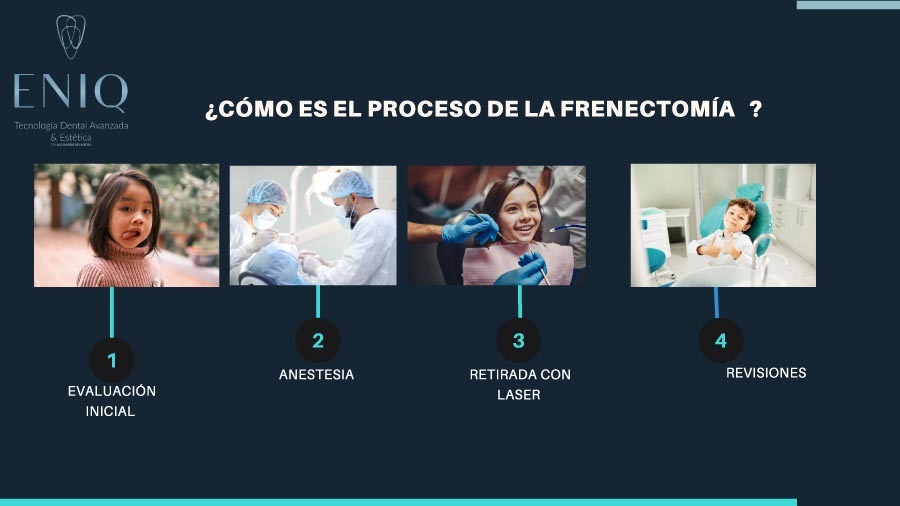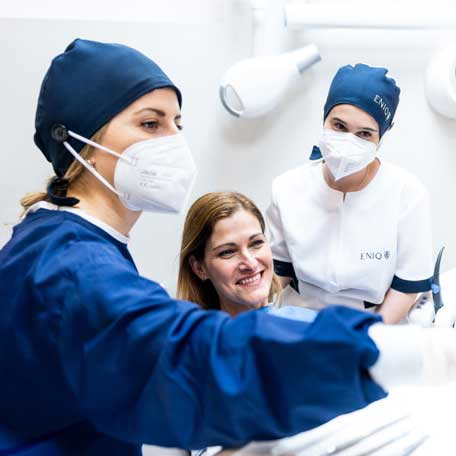

Frenectomy
ENIQ, your clinic in Madrid for precise and careful frenectomies.
What is a Frenectomy?
Pulpectomy is a dental procedure performed to treat an infection or injury in the dental pulp, which is the soft and nerve tissue located in the center of the tooth. This technique is primarily carried out on primary teeth (milk teeth) in children, although it can also be performed on permanent teeth in some cases.
The pulpectomy procedure is generally performed under local anesthesia to ensure that the patient is comfortable and pain-free during the treatment. The basic steps involved in the process are described below:
- Preparation: The dentist or endodontist prepares the work area by placing a sterile field around the affected tooth to keep it clean and free from bacteria.
- Access to the pulp: An opening is made in the crown of the tooth to access the dental pulp. The decayed or infected tissue is removed, and the damaged pulp remains are eliminated.
- Cleaning and shaping of the root canal: Using small files and other instruments, the root canals are cleaned and shaped to remove any residue of infected pulp tissue and prepare them for later filling.
- Irrigation and disinfection: Irrigating solutions, such as sodium hypochlorite, are used to remove bacteria and disinfect the root canals.
- Root canal filling: Once the canals are clean and dry, they are filled with a biocompatible material, such as gutta-percha, to seal them and prevent re-infection. In some cases, additional filling material, such as dental cement, may be necessary to ensure a proper seal.
- Restoration of the tooth: After completing the pulpectomy, the lost dental structure is restored. In the case of primary teeth, a stainless-steel crown may be used to protect the tooth until it falls out naturally. For permanent teeth, a filling restoration or dental crown may be required.
It is important to note that pulpectomy is a specialized treatment that should be performed by a dentist or endodontist with experience in these types of procedures. Each case may vary according to the patient's dental condition, so it is essential to consult a professional for an accurate diagnosis and an appropriate treatment plan.
What is the process followed in a frenectomy?
The frenectomy procedure generally involves the following steps:
- Initial evaluation: The dentist or periodontist will evaluate the problematic frenulum and determine if a frenectomy is necessary. The length, thickness, and location of the frenulum, as well as any functional or aesthetic problems associated with it, will be examined.
- Anesthesia: Before the procedure, local anesthesia will be administered to numb the area where the frenectomy will be performed. This ensures that the patient is comfortable and free of pain during the procedure.
- Preparation of the area: The frenectomy area will be prepared with proper cleaning and disinfection. Antiseptic solutions may be used to minimize the risk of infection.
- Incision and removal of the frenulum: A precise incision will be made in the frenulum to separate it from the surrounding tissues. The incision technique can vary depending on the location and characteristics of the frenulum. Appropriate surgical instruments will be used to safely cut or remove the frenulum. It may be done with a laser, which will not require sutures.
- Closure and suturing (if necessary): Depending on the case, it may be necessary to close the wound with sutures. The type of sutures used can vary, from self-dissolving sutures to sutures that need to be removed in a follow-up visit.
- Post-procedure instructions: After the frenectomy, specific instructions will be provided for wound care and promoting proper healing. This may include recommendations on mouth rinses, oral hygiene care, and a soft diet for the first few days.
It is important to note that frenectomy is a relatively simple procedure and is usually performed in a dental office. The duration of the procedure can vary depending on the complexity of the frenulum and the technique used. The dentist or periodontist will be able to provide more detailed and personalized information about the frenectomy procedure in each specific case.

Evaluation
Is a frenectomy always indispensable?
A frenectomy is not always necessary. The decision to perform a frenectomy is based on the individual assessment of each patient by the dentist or periodontal specialist. A frenectomy is recommended when the oral frenulum has abnormalities that cause functional or aesthetic problems.
Some situations in which a frenectomy may be considered include:

- Tongue movement restriction: If the lingual frenulum is too short or tight, it can limit the ability to move the tongue freely, which can affect speech, swallowing, and oral hygiene.
- Front teeth separation: An abnormal labial frenulum can cause gaps or diastemas between the upper front teeth, affecting dental aesthetics.
It is important to note that not everyone requires a frenectomy and that each case is unique. The dentist or periodontal specialist will carefully assess the individual situation of the patient and recommend a frenectomy only when necessary. If you have concerns related to your oral frenulum, I recommend consulting a dentist for a personalized evaluation and specific recommendations for your case.
What are the advantages of performing a frenectomy at ENIQ?
Technology can play a significant role in the frenectomy procedure, providing several additional benefits. Below are some of the benefits of using technology in a frenectomy:
- Enhanced precision: Modern technology, such as dental lasers or computer-assisted cutting devices, allows for greater precision in the frenectomy procedure. These tools can control and adjust the power, duration, and exact location of the cut, helping to avoid damage to surrounding tissues and promoting faster and more accurate healing.
- Less invasive: Using cutting-edge technology, such as dental lasers or precision surgical devices, less invasive frenectomies are possible. This can result in less manipulation of tissues and less damage to adjacent structures, which in turn can lead to quicker recovery and reduced postoperative discomfort.
- Faster healing: Technology, like the dental laser, can help seal blood vessels and promote quicker and more efficient wound healing. Additionally, some modern technologies have antibacterial properties, which can help reduce the risk of infection and promote faster recovery.
- Reduced bleeding: The use of advanced technology in a frenectomy, such as dental lasers, can significantly reduce bleeding during the procedure. This not only provides a clearer field of vision for the dentist but also lessens the discomfort and risks associated with excessive bleeding.
- Improved patient experience: Modern technology can enhance the overall patient experience during a frenectomy. Being less invasive and providing quicker recovery, patients may experience less pain, swelling, and discomfort post-procedure. Additionally, technology-assisted techniques can reduce anxiety and stress associated with dental treatment.
It is important to note that not all frenectomy situations will require the use of advanced technology, and each case should be evaluated individually. Technology is an additional tool that can enhance precision, efficiency, and the patient experience during the frenectomy procedure. Consult a dentist or periodontal specialist for more information on how technology can benefit your specific case.
How much do frenectomy procedure cost?
The frenectomy in Spain ranges from 150€ to 500 € depending on the degree of difficulty. You should also consider the price of the speech therapist that a child may need to consult.

- Financing: Up to 24 months interest-free. Up to 60 months with preferential conditions.
- Payment breakdown: Pay monthly in comfortable installments for the treatment.
- Discount for early payment: Paying for the entire treatment at the beginning.
- Multiple payment options: Direct debit, credit card, cash, transfer, Apple Pay, Google Pay, and Bizum.
Frenectomy
Precise Procedure
*subject to specialist assessment
-
All inclusive
-
Interest-free financing
Frequently Asked Questions
Do you have more questions about pediatric frenectomy?
Thanks to local anesthesia, the patient does not feel pain during the procedure. There may be some discomfort or swelling after the surgery, but it is generally manageable with pain medication and heals within a few days.
The recovery time varies depending on the complexity of the procedure and the individual, but it is generally short. Most people can resume their normal activities the next day, although it is recommended to avoid very hot or spicy foods and follow good oral hygiene to promote healing.
